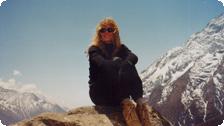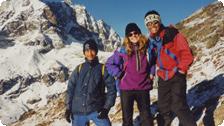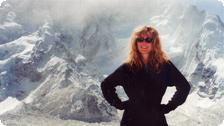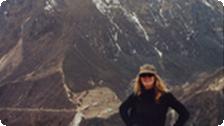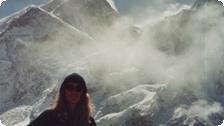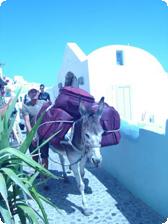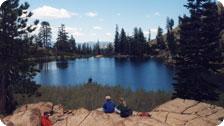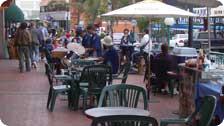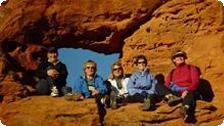Wellness: Nepal: Solo in the Himalayas
I was 21,000 feet in the air in the Himalayas, in a rattletrap plane even more flimsy than the Palm Desert skydiving tin can I had braved the previous month before, when I realized what I was doing.
My guide, Dahn, grinned at me. We were headed for Lukla, a tiny mountain town that would be our starting point for a twenty-day trek into the highest mountain range in the world. We were aiming for two 18,000-foot-plus peaks in the Everest region: Gokyo Ri and Kala Pattar.
The decision to take this Himalayan trek was a mixture of both fate and bravado. On the fate side of the coin was a series of Nepalese road signs that kept falling into my path; the latter was a pair of antique scissors I picked up in a trinket shop in the California wine country. Holding them up to the light, I heard the shop owner yell, “Those are from Nepal—and you should go!” I left the store with the scissors and the name of a woman who booked trekking expeditions across the Himalayas and India.
My solo fate was sealed in a simple moment of daring: Effie Fletcher, president of Himalayan High Treks in San Francisco, called to say that all five of my compatriots on the six-person tour I had signed up for had bailed. Baiting me, she asked, “You don’t want to go alone, do you?” “Yes!” I said without thinking. Never a girl to cry uncle where adventure is concerned, I packed up, showed up, and set out.
Days later I would fly high above the mountains I was about to climb, looking down upon my destination. “Kala Pattar,” I said to myself slowly, rolling the words around in my mouth while the plane jolted and swerved. In a few weeks I would be standing 2,000 feet above Everest Base Camp, leaning upon the 19,000-foot mountaintop that would likely be the highest elevation I would ever stand upon in my lifetime.
Suddenly, and without warning, our little sixteen-seat aircraft took a serious dive nearly straight down through the peaks, and landed—if you could call it that—on a 500-foot strip of loose gravel. The whole thing took less than sixty seconds. Skydiving had nothing on our pilot’s moves, and we cheered for him like he was Santa Claus.
Nepal, for me, was a “no-muss, no fuss” experience, and with the humble grace inherent in everything I had seen the previous four days in Katmandu, we set off on our twenty-day trek without a word. No pomp, no circumstance. Out of the plane, load your pack, and start walking.
Dahn, my guide, and Ishor, who would carry my heavy gear, were cousins in their early twenties. Dahn spoke very good English, Ishor almost none, and we had met only hours before the plane ride to Lukla. The Nepalese are a gentle-souled people, and when I took off walking at my Guns-of-Navarone, Let’s-Take-This-Mountain pace, Dahn only said gently, “Go slowly. There’s much more walking ahead.” When I did slow down, I fell into a steady, metered climb just behind him, a rhythm I still hear inside my moving limbs any time I hike.
The first half-day was beautifully scenic—centuries old rock fences lined with small farming plots, many of them abandoned hundreds of years before. The trail was peppered with wild rhododendrons, fluorescent green grasses, and the mists of the Dudh Kosi river—a bright emerald and voluptuous snake of a waterway that would guide us all the way up the valley.
At the end of the first day’s trekking, we stopped at Phak-Ding, a tiny, two-teahouse spot located across a rickety rope bridge over a river. Teahouses—as accommodations are called on the trekking trail—are mountain lodges named for the strong milk tea they serve all day long to trekkers. There are no formalities about them: stone outer walls and wood plank floors, a central dining room with a wood stove (which mostly burns yak dung to save wood), a dark kitchen, and a few rooms with built-in wooden cots covered with a thin foam lining. Teahouses look like mining town shanties, complete with cracks in the walls which let the cold—and often the snow—blow in.
When we unpacked, I realized that Ishor’s carrying strap had accidentally squeezed out all of my contact solution. It really was the only thing I couldn’t live without. I wandered down to the campsite below the teahouses where I had heard Everest climbers were camping. The Everest Team was composed of Yanks, Brits, and Australians, along with a whole team of supporters who would staff Base Camp. After a gracious loan of the precious liquid I needed, I was invited to trek with them until our paths divided.
Climbers are an interesting sort—all North Face vests, Gortex boots, Velcro sandals, and bits of gear stuck to their bodies by assorted zippers and straps. Their stories are peppered with daring leaps over icefalls, near escapes from crevasses, cramp-on mishaps, and foiled attempts at summiting.
They told me to skip the altitude medicine (it would make my vision blur and my hands tingle), to drink three liters of water throughout the day (to avoid altitude sickness), and to stop and breathe deeply whenever I felt light-headed. I did, and I never had a problem, not even at 19,000 feet. Trekking up the steep slope to Namche Bazaaar the next day, Dahn would stop and say, “I think you are very healthy.” I smiled.
Our first peak would be Gokyo Ri, almost 18,000 feet in height, and 9,000 feet from our starting point in Lukla. Namche, at 11,500 feet, would be our first acclimatizing stop. We would stay two nights there to let our blood and brains adjust, take a day trek on the “rest day,” go up in elevation, and come back down again to help our bodies acclimatize.
On the morning of our “rest day” trek, I asked Dahn if we could hike to the Thami Monastery at 13,000 feet. His eyebrows rose. “My guidebook says it’s a two-hour trek.” He smiled gently and said, “I will take you.” I have decided to stop saying things are hard in life, and instead refer to them as challenging. The trek to Thami gave new meaning to the word. Six-and-a-half hours of uphill climbing up above the tree line, and ascending up trail after trail of heavily snow-covered paths, we finally reached it.
Steep and grueling as the trek was, the monastery was worth every step. It was one of the most exquisite sites I would see on the trip. The temple was painted red on the outside and sat perched on the side of sharply peaked glacial mountains like a chalet. At the door, we took off our boots (a fellow American traveler laughed at me for wearing my Oakland Raiders socks in such an esoteric locale) and passed through the cloth tapestries to enter. A stunningly beautiful prayer wheel, giant in size, sat right in the entryway painted in gorgeous reds, blues, greens, and yellows.
I had seen prayer wheels all along the trails so far: small metallic or wooden cylinders, about a foot high with Tibetan markings on them. Rows of them would be built into a roadside trail to bless passersby as we twirled them with one hand, a walking prayer. In the Thami monastery, the prayer wheel was eight feet high and about six feet in circumference, carved and brightly painted. As I walked around it twirling it on its axis, I felt the special blessing it was reputed to bring.
I sat on my knees and let the place sink into my skin. Thangkas—religious tapestries depicting Buddhist deities—lined the walls. Prayer scrolls filled endless tiny bureau drawers built into the temple’s inner perimeter. Thick red curtains shielded the windows from the light, and a golden Buddha, raised on an altar, sat in the center of the room. It was gorgeous.
The trek back to Namche would test me in ways I did not know were possible. It was late in the day, cold was settling in, and we still had a two-and-a-half hour trek to return to our teahouse and acclimatize. Though I had trained for this, about an hour into the descent I began to get scared. I was over-tired, chilled, a little delirious from altitude and exertion, and the bones in my left foot were starting to strain and ache. “Stress fracture,” I thought, with the instantaneous sense memory that only an old injury can bring. Dahn saw my concern, and we stopped for a moment to rest.
“You must rest to walk,” he said, “and then go quickly. It is too cold in the dark.” I looked up at the peaks above me—this extreme range of rock that had pushed its way through centuries of the earth’s crust to stand in grandeur unequalled by anything I had ever seen before. Just a day ago I had heard a Nepalese woman talking about the Spirit of the mountains. The Tibetans believe that the Himalayas are an embodiment of mystical kings and queens, and when in trouble, they call on the spirit of the mountains to grace them with help. I had nothing to lose.
I said a prayer in that moment, asking for whatever forces that had built these majestic peaks to come up underneath my feet and grant me the strength to complete this trek. In the next seventeen days, I would have no injuries, no colds, no bronchial trouble, no blisters, no need for painkillers. Call it what you will: I called it mysticism.
Over the next few days on the trails from Khumjung to Dole to Macherma, the climate would grow colder each day, with snow falling in the late afternoon, and then clearing before sunset—just long enough to climb up a mountainside and watch the sun catch each golden twinkle of lingering snowflake, light pouring through the mountain peaks in a design of sun-splayed rays more exquisite than any kaleidoscope.
Miles of wilderness stretched between the few lodges, with almost no other structures populating the valleys. The local women farmed potatoes and some meager cabbages in the frozen ground and tended the teahouses, their men gone for the season to porter gear for trekkers and expeditions.
Each day when we arrived, the hostesses would invite us into the dark kitchen to eat boiled potatoes dipped in ground hot chili and oil. The women would always look at me curiously, asking Ishor and Dahn about me, and half-smiling at me as they checked me out. I was quiet during these inquisitions, and waited for their scrutiny to soften, as it always did. I owe a lot to Dahn for these moments, for I knew that how he presented me was how they would see me. In his easy, openhearted way, his laughter bridged the gap between our vastly different worlds.
After the first few days of being welcomed into Nepalese kitchens with Dan and Ishor, I took to eating on their schedule: tea or hot milk at breakfast, Sherpa stew or “mess” (a goopy buckwheat ball in broth akin to matzo-ball soup) at nine thirty or ten, soup or noodles at midday, potatoes in the afternoon, and whatever protein I could muster up at dinner. Dhal bat, a curried potato and lentil stew served over rice, was the main staple. Beer became a day’s end reward, and a Snickers bar was the official trekker’s snack. All the lodges carried the exact same items: a few Snickers and Mars bars, bottled water, Coke, Sprite, Tuborg and Carlsberg beer, and toilet paper. That was it. Nothing else.
By the time we reached Macherma, anything with water in it would freeze solid by morning. I slept with my contact lenses and drinking water in my sleeping bag, fully clothed inside my down parka. Unlike many other trekkers (one Brit bragged that he hadn’t washed his hair in seventeen days), I took a bath in a bowl at the end of each day’s trek. Since our rooms often had wind-whipping drafts of icy air creeping in from outside, this was no small feat. The hostess would boil a big metal pan of water for me, and I would undress piece by piece, wash, re-dress, and dunk my head. I hated doing it, but afterwards it always felt wonderful to get all that trail grime off of me. I would forego any “showers” up in the high country: my one attempt to bathe under stove-heated water dribbling from a gravity-driven showerhead would end in a soap-covered, waterless disaster inside a barely constructed corrugated shack with freezing snow blowing through it onto my naked body. Once was enough.
The night before we summited Gokyo Ri, I awoke out of a restless sleep to find the moon shining straight into my window like a laser beam from heaven, beckoning me outside. Looking up as I stepped out, I almost tripped over the head of yak sleeping at the foot of the door. The moon was incredible: cutting through the blue-black sky like a sun from another planet, it backlit the mountains so they appeared to have been lifted off the canvas of earth’s horizon, leaning towards me in anticipation. The sky was cobalt blue with black edges, and the snow-dusted frozen lake turned a pale violet in the sky’s reflection. It was otherworldly.
I realized I was on another planet, a place called the top of the world, and much like the depths of the ocean, it was a place I had never before inhabited. As I walked toward the lake, the stars were a flurry of abstract art, washes of whole galaxies painted on the sky inside some kind of infinite myth invented just for us. It was exquisite and incredible, and it humbled me.
The next morning the trek up Goyko was a don’t-lose-your-footing, don’t-lean-back, straight-up climb. The trail simply went directly up the mountain, with none of that Western zigzagging. The air had become markedly thinner after the first half-hour, and breathing became a Zen practice. So far, I had been moving into Dahn’s pace whenever the trek got tough, and now I stepped right in behind him, hugging his back step for step, like an 800-meter runner who’s letting the frontrunner break the wind.
Walking with others in the wilderness is an intimate practice, a slowing down of all the stuff of daily life, requiring a sensitivity toward each other and a willingness to know without speaking. Dahn, in his quiet assurance, had this quality in abundance. Thinking about it as we were heading up Gokyo Ri, I realized what talkers we are in the West: our days are filled with word noise. And though the world of words is a precious land to me as a writer, the ability to intuit, to know beyond literal sound, is a quality that is developed in quietness and stillness. As we three crested the top of Gokyo Ri, climbing into the completely silent, golden-splayed rays of the morning sun just burning over the peaks, every visible thing was filled with its soundless, omnipresent fire. The entire sky was ablaze with a kaleidoscope of light, and the absolute passion of the moment rushed toward me in an epiphany. This rocked.
The view was breathtaking, with a three-sixty sight line to Everest, Cho Oyu, Nuptse, Lhotse, Makalu, and several other peaks. I twirled around like a seven-year-old, blurring the heights of the snow-crested horizon line and then took pictures, Hockney style, across each piece of the mountain sky. Dahn and Ishor climbed the rock piles and tucked Tibetan prayer flags across the top of the peak. I leaned over the edge to where our teahouse blurred into a small blip 2,400 feet below us, and even the lake looked like a small puddle. We had really climbed. I took some more photos, not caring that the majesty of this moment wouldn’t even remotely translate through a camera—I would know; I would remember.
The day after reaching Gokyo Ri’s peak, we came down the valley very fast on the opposite side of the Dudh Kosi river gorge, practically jogging sometimes with the effortless exhilaration of going down. Coming down quickly was to feel a rush of pressure slowly release out of the altitude-balloon my head had become, and I felt a surge of pure, free-falling energy. As we walked, we had valley views so vast we could see whole weather systems moving in and out of the gorges, and it seemed as if we were witnessing life itself blowing its breath up the Everest valley. We would hike for several days through Phortse and Pangboche, and then head steadily up through Dengboche and Luboje.
The morning we hiked to Kala Pattar, our second peak, there was a perfect, fresh snow upon the ground, just enough to frost the earth. It was dark when we headed out, and the snow looked light blue and pristine in the pre-dawn morning. We took the back trail out of our lodge, sliding off the barely-there path cut sharply into the side of the mountain. We stopped for some Sherpa stew at Gorek Shep, and then got up to begin the ascent. Dahn looked at me with that now-familiar fire in his eyes that read, “Ready for this?” I laughed, knowing he was challenging me to compete with him; it was also my warning sign that I was in for a real push. Ishor, finally walking with only a daypack on, laughed at us both.
Kala Pattar is over 19,000 feet and looks straight into the highest mountain in the world, towering over the Everest Expedition base camp by about 2,000 feet. While Gokyo Ri had been a dirt-and-snow covered mountainside with a trail that went straight up to a plateau peak, Kala Pattar, by contrast, was all rock. There was no “trail” to speak of, and it looked like some deity had just dropped an unbelievable amount of broken stones atop the entire mountain. With snow dusting each rock and the sun not yet moving over the peak, it was definitely an ankle-twisting threat. I held my breath and steadied my concentration. Once again, we moved straight up at an incredibly steep incline, using hands and feet to balance and pull ourselves skyward. It was like scaling some sort of ancient stone earth-archive, with barely any air to breathe. I truly felt like I was walking on the moon.
For the next hour and a half we climbed boulders and stones, moving up into the sky. Each exertion required more air—and less of it was there. Yet I could feel something inside me jangling like a bell choir, a celebration brewing that was getting ready to sing out with the simple matter of a few more steps. I coached myself: Just another step up! Push yourself! Breathe easy. Easier. Alright! Again. Dahn and Ishor, usually unaffected by the altitude, were visibly panting.
Finally we took our last steps up to the crest of the peak—and the bells began to go off in my head. With my last push up, I closed my eyes and gulped in a huge new breath. We had done it! Then I turned around to face my destination, my goal of all goals for days and days now, and as I opened my eyes, there she was: Sagarmatha, Goddess of the Sky. Mount Everest, highest place on earth, right here in front of me. I looked straight into her, her famous white plum gracing the top of world, as the sun began to burn its fanned rays over the peak. Oh, it was majestic! Mythical! Exquisite and unmatched by anything else I had seen. Snow and rock, sky and atmosphere—simple things, really, yet I felt a reverence no cathedral or temple any place on earth could match. Bright white snow glistened all over her like twinkling glass in the crisp air, and plumes of ethereal clouds rose up from the sides of the peak, giving the appearance that the snow was dancing in mid-air. And the sun! Suddenly the whole Everest valley was being illuminated as if a golden floodlight had come up from the ground and moved the scenery up toward us in a rush of light.
Dahn, Ishor, and I slapped hands, hugged, and cheered each other. Twenty or so trekkers joined us at the small plateau of rock which was the peak, and we all had grins on our faces miles wide. I began to eye the very large, sheer piece of rock that looked to be the highest point on the peak. It was about fifteen feet higher than the plateau where we were standing, and its point dropped off sharply on both sides to the valley floor, over 1,000 feet below. Dahn watched me eyeing it, and said, “Now, you don’t need to go up there, do you?” I flashed him a grin, “Oh, but I do…”
I slid my rear end up the slick side of the rock and snaked my way up to the top of it, Dahn and Ishor eyeing me, then following me. Suddenly I heard a rumbling like the sound of five earthquakes rolled together—a low and growing groan from inside the earth, gathering momentum from across the valley. It made my knees go weak.
I was about ready to catapult down the rock anyway I could, when Dahn touched my arm and pointed across the gorge to Lhotse, the mountain just next to Everest. “Avalanche,” he whispered. I sat stock-still and watched a whole chunk of the mountainside fall in a huge mass of ice and snow, bellowing like mythic thunder, and landing with a sonic-boom crash. Snow blew up around it like a nuclear cloud. A wave of humility washed over me then, experiencing first hand the vastness of the power in this place.
I sat quietly for a moment, remembering that we did not do this alone, that we were helped and supported along the way by all kinds of things—fueled by the hands and hearts that fed us, guided us, housed us, and many, many more who had, years ago, simply taken adventure by the hand and walked up this vast valley. And here I was with The Thing Done, completed, accomplished. I sat on the very top of my own achievement, looking out from its mountaintop.
“If I can do this, I can do anything,” I had said to myself before taking this trip. But sitting astride the loftiest piece of earth I have ever rested upon, I realized that it had become much more than that. It was about changing my perspective, the way I see things. Because here, now, at the journey’s destination, I could look out at the majesty in front of me and see that the trail that had looked like hardship had become the grandest view I have ever seen; what looked like difficulty had become a joy unparalleled; and what had seemed to be struggle became an opening into gifts so divine I could not have imagined them before now.
The trek down-valley was nothing but a delight for me. I was giddy with joy for the time we’d had and the thing we’d done, and supremely happy. To let myself walk downhill for a change, with nothing else to do but relish the accomplishment—what a revelation! I remembered walking into Namche the first time over two weeks earlier and thinking what a small and remote little place it was, with its fifty or sixty structures and its handful of mud-path shops. Now it seemed like a booming city to me. Back in town, we drank beer, ate yak steak, partied with our newfound trekking friends, and snacked on the local junk food: coarse popcorn and fried cheese curds. Sean, a good-hearted, boisterous construction worker from Boston, dug an Allman Brothers tape out of his pack to play on the pub owner’s deck, and, hearing the music, I felt America slowly come back to me.
One afternoon a few days later, as Dahn and I wandered out of a Tibetan jewelry store in Katmandu, a flash rainstorm caught us off guard and we found ourselves stranded in the dirt street, suddenly drenched. There was no place to go—no awnings or doorways close enough—and in twenty seconds the pouring rain had stuck everything to our skin—clothes, hair, dirt, and humidity. We stood laughing at each other, surrendering to it, the rain welcome after all, cooling our sticky skin and dusty feet. It struck me then, cracking up over our meager attempts to get a cab with our clothes drenched and our hair dripping, that in a few short hours I wasn’t going to see him, or Ishor, anymore. It was time to say goodbye, time to head back home, and as I caught his gaze, I felt my heart well up with the knowledge that acts of grace and companionship last a lifetime. I was deeply moved that he and Ishor had graced me during my discovery of their homeland.
When we finally ducked into a taxi, a Joan Baez song was playing on the tinny radio with some sixties lyrics about change and moving on. I was filled with a perfect-moment nostalgia for my time in a land which I had never thought to know: a land which taught me to accept change and challenge, and to walk through obstacles—not away from them. What a gift, I whispered to myself, thinking of Everest.
At home now on the coast of America, I stand outside on my veranda watching the sunset at the end of the day, and I feel myself connected to Nepal, to the other side of the world. That simple feeling widens my heart.
Discover more from Tango Diva
Subscribe to get the latest posts sent to your email.
